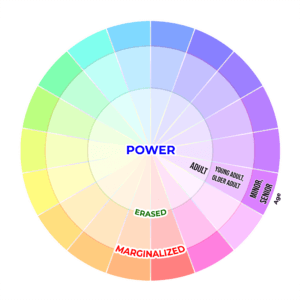This article is part of my intersectional series on diversity, equity, and inclusion (DEI) that discusses an individual wedge, or demographic category, in my infographic adaptation of the wheel of privilege.
When we look at age as a privilege, we are looking at age alone as a factor for how bias determines someone’s credibility, trust, competence, and how much value we place on people’s opinions based on the number of years they existed on this planet.
What age holds the most privilege?

Age is an interesting sector. Most demographic categories in the spectrum of power are linear from one extreme being the most powerless to the other extreme being the most powerful and the struggles of those in the middle are ignored or erased (i.e. melanin being an example ranging from white to Black).
Age, however, both extremes are often discriminated against while the middle is the most powerful. The very young and very old often receive little to no autonomy or respect while middle-aged adults have the most. The closer you are to this middling range, the more people will listen to you. As a child gets older, their opinions hold more weight but as people become elderly, people’s respect toward them wanes.
Of course, this may also differ depending on circumstances, as we know the average age of U.S. Senators is 62. The tech industry prefers to hire young adults in their 20’s and 30’s.
Overall, it seems like people aged 30-60 are considered the most privileged age-wise. Any younger and they get written off for not having enough life experience. Any older and they’re suddenly too senile or irrelevant to society to matter.
What is ageism?
Ageism is prejudice or discrimination against a particular age group or individual people based on their age. Like all types of discrimination, it can be overt, covert, casual, and systemic.
The word “ageism” was coined by Robert Butler in 1975 and he defined it as:
a process of systematic stereotyping or discrimination against people because they are old… Ageism allows the younger generations to see older people as different than themselves; thus they subtly cease to identify with their elders as human beings.
Robert Butler (1975)
Ageism is often treated differently than other types of discrimination because it is inevitable that we all grow old, so many people tend to disregard this entire wedge as “not as bad” as some of the others.
Examples of Ageism
- Choosing not to get vaccinated for COVID-19 because the risk of mortality increases with age, with the highest being aged 75 and older
- Being fired from your job, or refusing to be hired, for being over a certain age
- Viewing older people as out of touch, less productive, or stuck in their ways
- Viewing younger people as unskilled, irresponsible, or untrustworthy
- Making offensive generalizations about a specific generation, e.g. that millennials are entitled
- Around 1 in 6 people aged 60 and older experience some form of elder abuse
Ageism is often intersectional with disability, mental health, and neurodiversity. Some able-bodied people become disabled with age. Some people develop mental health conditions associated with age like dementia. Neurodivergent people may experience their cognitive deficits worsen with age.
What is childism?
Childism, closely related to ageism, is a prejudice or discrimination against children or adults with childlike qualities. The concept of childism was first described by Chester M. Pierce and Gail B. Allen in their article titled, “Childism”:
Childism is the automatic presumption of superiority of any adult over any child; it results in the adult’s needs, desires, hopes, and fears taking unquestioned precedence over those of the child. It goes beyond the biologic necessity that requires adults to sustain the species by means of authoritative, unilateral decisions. What is at issue is how the decision is executed and how the child is afforded dignity and respect.
Childism (1975)
Childism is intersectional with disability, mental health, and neurodiversity too. Children, teens, and young adults are often dismissed when talking about physical issues because older people may claim they are “too young” to have “those types of problems.”
Examples of Childism
- Forcing children to meet a developmental milestone based on their age or because the caregiver decided (3-day potty training techniques, parent-led potty training, enforcing whole-body listening)
- Withholding food, water, or attention until they say “please,” ask it in a full sentence, or say it in an “appropriate” tone (also known as tone-policing)
- Having questions asked to your caretaker instead of you when you can communicate
- Having your emotions elicit laughter or anger from others instead of being met with empathy
Despite the name, adults can experience childism too. Adults that have childlike behaviors, appearance, interests, and thinking patterns get discriminated in this same manner. This includes dwarves and short people, autistic teens and adults, people with intellectual disabilities, those with Down Syndrome, and many more.
These adults are often treated with less respect than their peers because stereotypes portray them as unintelligent, unable to learn, and no capitalistic value to society. We are seen as simply existing as a burden to others.
Featured image photo by Nourdine Diouane on Unsplash.
Sources
- “Ageing: Ageism Q&A” (Nov. 2, 2020). World Health Organization (WHO).
- Becca R. Levy, Martin D. Slade, Suzanne R. Kunkel, Stanislav V. Kasl, “Longevity increased by positive self-perceptions of aging” (Aug. 28, 2002). Journal of Personality and Social Psychology.
- “Ageism: Concepts and Theories” Law Commission of Ontario.
- Isaac Sasson, “Age and COVID-19 mortality: A comparison of Gompertz doubling time across countries and causes of death” (Feb. 17, 2021). Demographic Research: A peer-reviewed, open access journal of population sciences.
- “Elder Abuse Fact Sheet” (Oct. 4, 2021). World Health Organization (WHO).
- Chester M. Pierce, MD and Gail B. Allen, MD, “Childism” (Jul. 1, 1975). Psychiatric Annals.
- Sara, “We Need to Talk About Childism” (Aug. 28, 2016). Happiness is Here.
- Darcia F. Narvaez, Ph.D, “Are You a ‘Childist?’ Is Prejudice against children universal?” (Apr. 22, 2012). Psychology Today.
